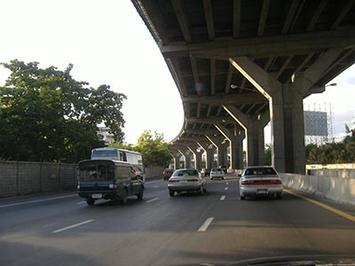
Dallas-Fort Worth and Dayton Ohio have the least traffic congestion among larger cities (urban areas) in the world, according to the 2017 Tom Tom Traffic Index. Dallas-Fort Worth had the shortest average all day delay, at 18 percent of the 43 cities with more than 5 million population. Dallas-Fort Worth also had the least average peak period traffic delay. This is the second year in a row the Dallas Fort Worth has had the best all day traffic congestion. Dayton had the best all day and average peak hour congestion among the 146 cities with between 800,000 and 5,000,000 population and tied with three others for the best in among all cities the least all-day congestion.
All City Rankings
Among all city sizes, Syracuse (NY), Greensboro (NC), Winston-Salem (NC) and Dayton had the best all day traffic, with a nine percent average delay. Cadiz, Spain had the best average peak hour congestion, with an 11.5 percent delay.
Mexico City had the most intense all day congestion, at 66 percent, followed closely by Bangkok at 61 percent. Other cities with the most congestion include, not surprisingly, Chongqing, Jakarta, Istanbul and Beijing. All have large populations, high densities and millions of cars. A real surprise, however is Lodz, Poland, with a population of less than 750,000, which has the fourth worst congestion (Figure 1)
Bangkok ranked the most congested city, in the AM and PM peak periods, with an average traffic delay of 104.5 percent. This means that it takes twice as long in Bangkok to make a trip as it would if traffic flowed freely. Mexico City had the second largest delay at 98.5 percent, followed by Bucharest (Romania) at 94.0 percent. Bucharest heavy traffic congestion surprises, since it has, at best, only one-fifth the population of the largest seven most congested cities. Even more surprising is that much smaller Belfast is the sixth most congested, while Dublin, smaller than Bucharest, ranks seventh (Figure 2).
Cities Over 5,000,000 Population
Out of the 43 cities with more than 5 million population, three US cities (Philadelphia, Houston and Chicago) and Madrid join Dallas-Fort Worth in having the least all-day traffic congestion. The five cities with the most traffic congestion are Mexico City, Chongqing, Jakarta and Istanbul (Figure 3).
Three of the cities with the least average peak congestion are in the United States, including Dallas-Fort Worth, second-ranked Philadelphia and fourth-ranked Chicago. Madrid, again makes the top five in third position, while Sao Paulo ranks fifth (Figure 4). The Chinese cities of Quangzhou and Suzhou rank surprisingly well, in view of the national traffic congestion level (Table), at 6th and 9th least congested.
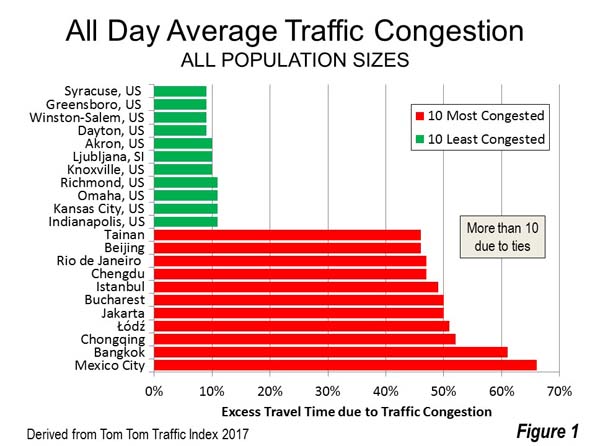

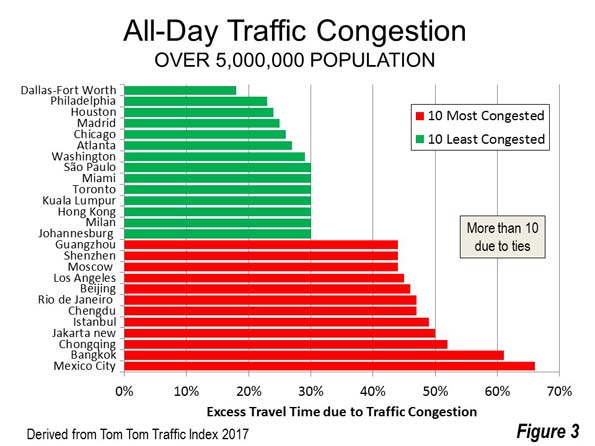

Cities with 800,000 to 5,000,000 Population
All 10 of the least congested cities between 800,000 and 5 million population all day are in the United States. The least congested are Dayton, Knoxville, Richmond, Omaha and Indianapolis, in a fifth-place tie with Kansas City.
Bucharest had the most all day congestion, followed by Tiainan, Changsha, Shijazhuang and Kaohsiung (Figure 5).
The eight least congested cities between 800,000 and 5 million population during peak periods are located in the United States, led by Dayton, Knoxville, Richmond, Tulsa, Worcester and Kansas City.
The greatest traffic congestion in this population category is in Bucharest, which is followed by Shijiazhuang, Changsha, Auckland and Zhuhai (Figure 6).
Cities with Less than 800,000 Population
The four cities with less than 800,000 population and the least all-day traffic congestion are in the United States, Winston-Salem (NC), Syracuse (NY), Greensboro (NC) and Akron (OH). The fifth best traffic congestion is in Ljubljiana, the capital of Slovenia.
The worst all day traffic congestion in this category is in already cited Lodz and Dublin, as well as Palermo, Belfast, Lublin (Poland) and Edinburgh (Figure 7).
Cadiz, Spain has the least peak period congestion in this population category, followed by four US cities, Syracuse, Greensboro, Akron and Winston-Salem.
The greatest average peak period congestion in the below 800,000 population category was in Belfast, followed by Dublin, Lodz, Wellington (NZ) and Edinburgh.
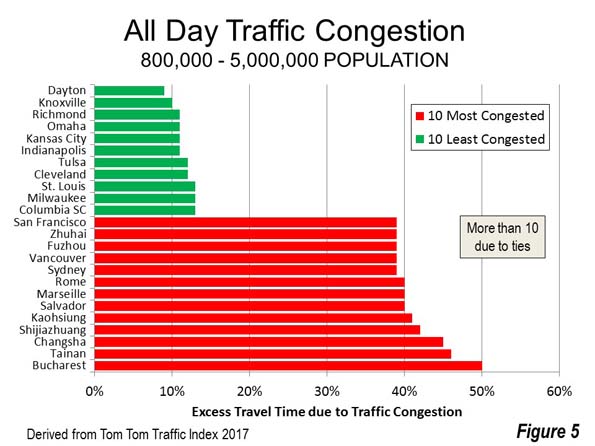
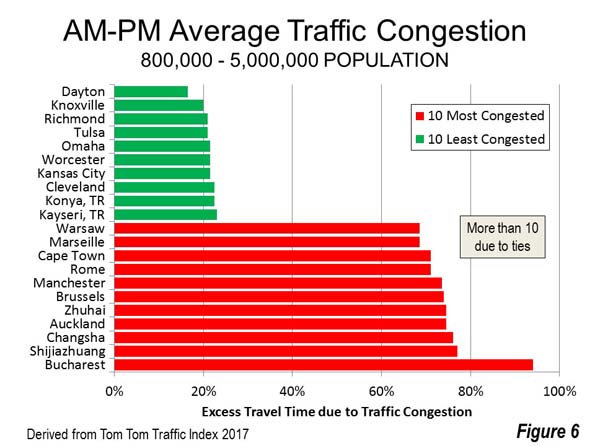

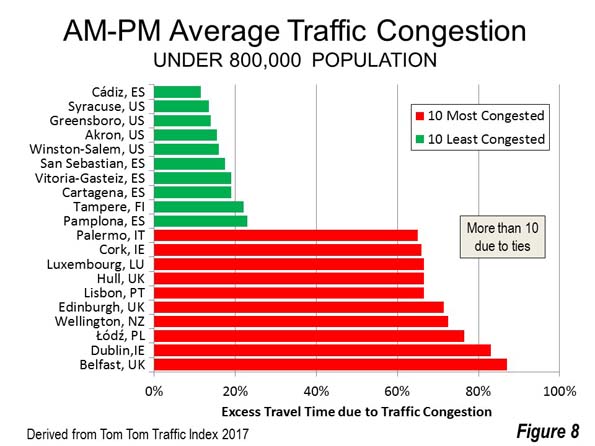
Traffic Congestion by Country and Geography
Among the nations, the US has the overall least traffic congestion, with a delay rate of 19.3 percent in all day congestion, followed by the Netherlands and Spain. The US leads in two population categories, 800,000 to 5,000,000 and under 800,000. Spain has the least over 5,000,000 congestion, where Madrid exhibits the impacts of its strong motorway system.
East Asian cities have the greatest all-day traffic congestion, at 41.1 percent, though among the largest cities Latin America has have most congestion.
In average peak period congestion, Spain shows the best results, with a delay rate of 29.0 percent, followed by the United States and the Middle-East. Spain leads in the over 5,000,000 category, Turkey in the 800,000 to 5,000,000 category and the United States in the under 800,000 category.
East Asian cities also have the greatest average peak period congestion, at 67.3 percent. Among the largest cities, congestion is greatest in the Eastern European cities outside Poland and Turkey (Table).
The Importance of Traffic Indexes
Cities are more productive if they facilitate greater access throughout their urbanization, especially for work trips, as Remy Prud’homme and Chang-Woon Lee at the University of Paris and David Hartgen and M. Gregory Fields of the University of North Carolina, Charlotte have shown. Traffic indexes provide important metrics to aid city officials in “keeping the traffic moving,” which is essential in the modern metropolitan area. Significantly, worldwide traffic indexes are covering more cities. This year’s Tom Tom Traffic Index added important cities like Jakarta, Hong Kong, Buenos Aires, Santiago de Chile, and Kuala Lumpur, bringing the total to 390. Today’s policy makers have far more information on which to evaluate transport investments than ever before.
| Table | |||||||||
| Summary of Traffic Congestion by Geography | |||||||||
| ALL DAY CONGESTION | AVERAGE AM-PM CONGESTION | ||||||||
| Country/Geography | Over 5 Million | 800,000-5 Million | Under 800,000 | All | Over 5 Million | 800,000-5 Million | Under 800,000 | All | Count by Population Category |
| ASIA | |||||||||
| China | 39.7% | 36.3% | 38.5% | 67.2% | 66.6% | 67.0% | 15, 8, 0 | ||
| East Asia: Other | 43.0% | 38.8% | 41.1% | 75.5% | 57.1% | 67.3% | 5, 4, 0 | ||
| Middle-East\ | 26.2% | 26.2% | 35.6% | 35.6% | 0, 5, 0 | ||||
| EUROPE | |||||||||
| France | 38.0% | 30.3% | 23.5% | 24.9% | 67.0% | 57.0% | 42.0% | 44.8% | 1, 3, 21 |
| Germany | 28.3% | 24.5% | 25.6% | 47.6% | 39.9% | 42.0% | 0, 7, 18 | ||
| Italy | 30.0% | 32.7% | 23.8% | 25.1% | 57.5% | 56.5% | 37.7% | 40.8% | 1, 3, 21 |
| Netherlands | 19.5% | 19.5% | 37.2% | 37.2% | 0, 0, 16 | ||||
| Spain | 25.0% | 27.0% | 20.3% | 21.0% | 45.5% | 41.5% | 27.1% | 29.0% | 1, 2, 22 |
| United Kingdom | 40.0% | 30.2% | 29.7% | 30.2% | 66.0% | 55.7% | 55.8% | 56.2% | 1, 6, 18 |
| Western Europe: Other | 29.3% | 24.2% | 25.1% | 52.8% | 42.1% | 44.1% | 0, 9, 38 | ||
| Poland | 27.0% | 32.7% | 31.8% | 48.3% | 53.0% | 52.2% | 0, 2, 10 | ||
| Turkey | 49.0% | 26.0% | 28.3% | 77.0% | 34.0% | 38.3% | 1, 9, 0 | ||
| Eastern Europe: Other | 42.5% | 31.6% | 21.1% | 27.9% | 80.0% | 61.1% | 43.9% | 55.3% | 2, 7, 8 |
| NORTH AMERICA | |||||||||
| Canada | 30.0% | 27.2% | 21.3% | 24.5% | 56.0% | 46.8% | 38.1% | 43.2% | 1, 5, 6 |
| United States | 28.6% | 18.5% | 15.0% | 19.3% | 52.7% | 34.6% | 24.2% | 35.5% | 9, 62, 9 |
| AUSTRALASIA | |||||||||
| Australia | 24.2% | 27.5% | 50.7% | 38.5% | 44.6% | 0, 5, 5 | |||
| New Zealand | 38.0% | 28.2% | 29.8% | 74.5% | 47.9% | 52.3% | 0, 1, 5 | ||
| OTHER | |||||||||
| Latin America | 44.6% | 29.1% | 35.6% | 72.9% | 51.1% | 60.2% | 5, 7, 0 | ||
| South Africa | 30.0% | 35.0% | 23.8% | 26.7% | 61.0% | 71.0% | 44.9% | 51.9% | 1, 1, 4 |
Wendell Cox is principal of Demographia, an international public policy and demographics firm. He is a Senior Fellow of the Center for Opportunity Urbanism (US), Senior Fellow for Housing Affordability and Municipal Policy for the Frontier Centre for Public Policy (Canada), and a member of the Board of Advisors of the Center for Demographics and Policy at Chapman University (California). He is co-author of the "Demographia International Housing Affordability Survey" and author of "Demographia World Urban Areas" and "War on the Dream: How Anti-Sprawl Policy Threatens the Quality of Life." He was appointed to three terms on the Los Angeles County Transportation Commission, where he served with the leading city and county leadership as the only non-elected member. He served as a visiting professor at the Conservatoire National des Arts et Metiers, a national university in Paris.
Photo: A Bangkok freeway, by author












